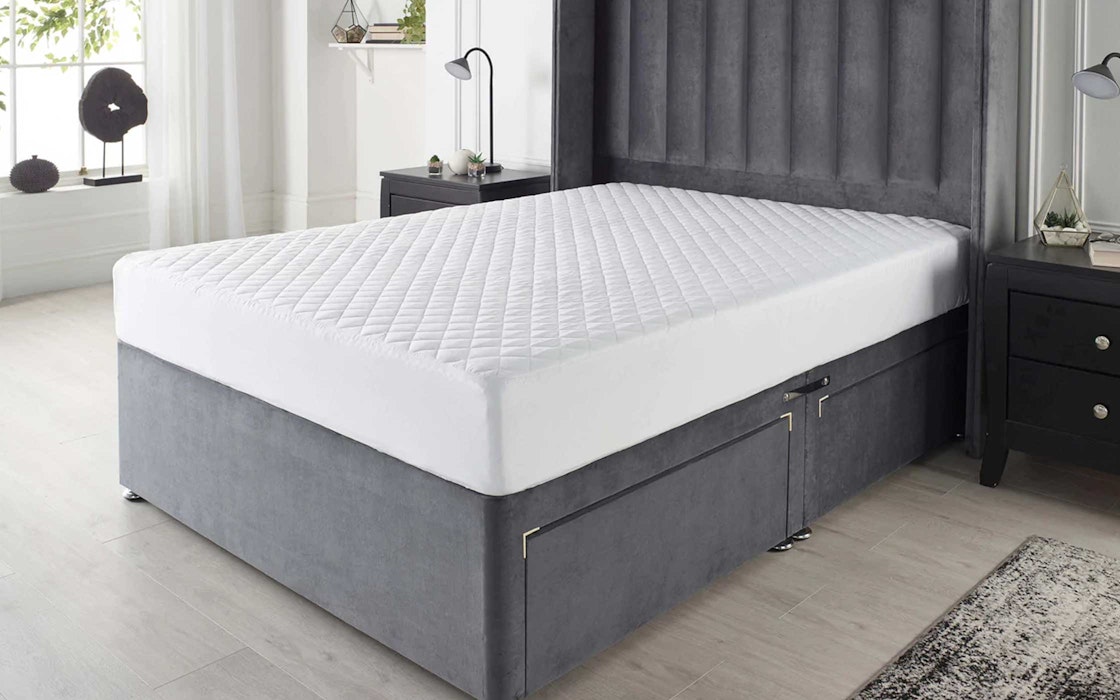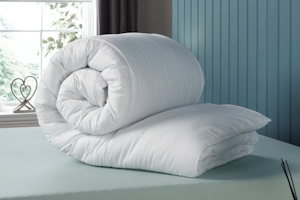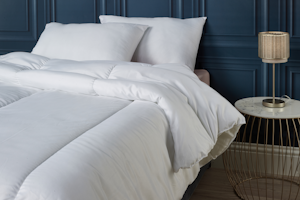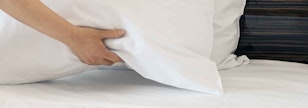20 Mar 2025

How Thick Should a Mattress Be?
17 Feb 2023
When searching for a new mattress, there are many obvious aspects to consider, from its size to its material and firmness. But, there’s one additional element you may not realise to be so important - that being the thickness of the mattress. A thick mattress does not necessarily equate to a comfier mattress, and not one thickness will suit all needs; this is why thickness should be a major consideration if you’re currently in the process of buying a new mattress.
When choosing the best mattress thickness, you must weigh up several other factors. These include the body weight of the sleepers, their typical sleeping position, and any health conditions or mobility issues they may have. From these considerations, you’ll need to pick an ideal thickness, whether that’s low profile, slim, standard, or deep. In general, extra deep mattresses are unnecessary no matter what the conditions are. Read on to find out our recommendations for each mattress thickness and which sleepers they will suit best.
Mattress Thickness Overview Chart
For a quick reference, see below an overview of various mattress thicknesses and their recommended uses and sleepers.
|
Mattress Thickness (inches) |
Mattress Thickness (cm) |
Thickness Descriptor |
Best Uses & Sleepers |
|
2 to 5 inches |
5 to 13cm |
Low Profile |
Cots Rollaway or trundle beds |
|
5 to 8 inches |
13 to 20cm |
Slim |
Children Shorter adults Sleepers with mobility issues |
|
8 to 12 inches |
20 to 30.5cm |
Standard |
Most adults Back or stomach sleepers Guest bedrooms |
|
12 to 20 inches |
30.5 to 51cm |
Deep, Thick, or Tall |
Side sleepers Plus-size sleepers |
|
20+ inches |
51+cm |
Extra Deep, Extra Thick, or Extra Tall |
Typically not recommended for any circumstance |
Mattress Thickness Detailed Breakdown
As you can see in the overview chart, different mattress thicknesses are best for different circumstances. We’ve further explained our recommendations for each mattress thickness in the following sections.
Low Profile (2 to 5 inches, 5cm to 13cm)
Low profile mattresses are the thinnest type available, measuring 2 to 5 inches (5 to 13cm) in depth.
These mattresses are typically used for infant and toddler beds like cots or bassinets; they’re also suitable for rollaway, trundle, and murphy beds that you may use when hosting guests. This is also the average thickness of most air mattresses. With that in mind, avoid using low profile mattresses unless you’re creating a bed for a young child.
Slim (5 to 8 inches, 13 to 20cm)
Slim mattresses are the next depth up in the thin mattress category, measuring 5 to 8 inches (13 to 20cm) deep.
These mattresses are best for slightly older children as they can comfortably support the typically lighter body weight of a child. For adults, a slim mattress may be preferable if the sleeper is particularly short or has limited mobility; a slim mattress provides the benefits of a lower bed height and improved accessibility for these sleepers without being uncomfortably thin.
Standard (8 to 12 inches, 20 to 30.5cm)
Standard mattresses come in at the mid-range of thicknesses, measuring 8 to 12 inches (20 to 30.5cm) deep.
As per the name, this is the standard thickness of the average mattress. Standard mattresses generally suit most adults and their usual sleeping positions; they’re a great choice for main bedrooms and guest bedrooms alike. Being the standard thickness, you’ll find the most variety with these mattresses in terms of materials, designs, and price points.
Deep, Thick, Tall (12 to 20 inches, 30.5 to 51cm)
Deep, thick, and tall mattresses offer a greater depth than the average mattress, measuring 12 to 20 inches (30.5 to 51cm) deep.
This category also includes a wide selection of thicknesses, but in most cases, anything over 14 inches would be unnecessary. In actual fact, most manufacturers don’t produce mattresses over 14 inches deep. Due to their thickness, these mattresses are particularly soft and durable; they are therefore preferable for side sleepers or sleepers with a heavier body weight.
Extra Deep, Extra Thick, or Extra Tall (20 inches+, 51cm+)
Extra deep, extra thick, and extra tall mattresses are any that measure over 20 inches (51cm) deep.
These mattresses are less commonplace as they’re generally unnecessary for most people; the extra depth makes them more expensive and more difficult to get into, hence why they’re not a popular choice. If you’re looking for a mattress thicker than the average size, a deep, thick, or tall product will suffice.
What Determines Mattress Thickness?
Mattress thickness is determined by the number and type of layers that make up the mattress in question. Inside their covers, mattresses can have between 2 and 5 layers, with most having 3 to 4 layers. These layers can be made from a variety of materials that influence the mattress’s feel, durability, and support. In all mattresses, there are two primary layers; the comfort layer and the base layer.
Comfort Layer
The comfort layer is the top, uppermost layer of the mattress. This layer acts as the mattress’s cushioning, there to support your body, relieve pressure, and regulate its temperature.
On most mattresses, the comfort layer measures roughly between 2 to 3 inches. Its thickness determines how soft or firm the overall mattress is; a thicker comfort layer creates a softer mattress, whereas firmer mattresses will have a thinner comfort layer. All mattresses have at least one of these layers, but some may have multiple to further enhance their cushioning. These layers may also be there to give the mattress additional features like improved cooling, zoned support, or adding extra bounce.
Base Layer
The base layer, or support layer, is the lower portion of the mattress. This layer acts as the mattress’s foundation, playing an equally important role in supporting your body. The quality of the base layer also impacts the durability and longevity of the mattress.
For it to do its job best, the base layer should make up at least 50% of the mattress’s total layers. For instance, if a mattress is 10 inches deep, its base layer alone should be at least 5 inches thick. This is essential to ensure that the mattress retains its durability and doesn’t sag prematurely.
How Thick Should My Mattress Be?
There are several aspects to consider when choosing the best mattress for the sleepers’ individual needs; these include the body weight of the sleepers, their typical sleeping position, and any health conditions or mobility issues they may have.
Body Weight of Sleepers
The body weight of the sleeper (or sleepers) will impact how much pressure is placed on the mattress. Because of this, you must consider your body type when deciding which mattress thickness would be best. This is crucial to ensure your mattress will properly and comfortably support your individual body. Our recommendations are as follows:
- Petite Sleepers (60kg or less): Petite sleepers place less pressure on their mattress, so, for them, a thinner mattress can feel too firm. For sleepers in this category, it’s best to opt for a 12-inch mattress that will sufficiently support this body weight by preventing pressure buildup.
- Average-Build Sleepers (60kg to 105kg): Sleepers with an average build will do best with a standard mattress between 10 and 12 inches thick. With that said, a slightly thicker or thinner mattress may be preferable depending on the sleeper’s typical sleeping position; we’ve provided further guidance on this in the next section.
- Plus-Size Sleepers (105kg or more): Sleepers with a heavier build should opt for a thicker mattress that’s at least 12 to 14 inches in depth. The mattress should also have a base layer of at least 6 inches. This thickness is necessary to prevent the mattress from sagging or degrading prematurely under the pressure of a heavier build.
Typical Sleeping Position
You should also factor in your typical sleeping position when deciding how thick your mattress should be. The position in which you sleep impacts the pressure points against your mattress and how it contours to your body. Here are some recommendations on mattress thicknesses for each sleeping position:
- Back Sleepers: A standard mattress of 10 to 12 inches will suit back sleepers best. This thickness provides support to the lower back and keeps the spine properly aligned. Ideally, the mattress should have a thick base layer with a thinner comfort layer to prevent sinking.
- Side Sleepers: Side sleepers should opt for a thicker mattress around 12 to 14 inches deep. For this position, it’s best to have a thicker comfort layer to contour around the hips and shoulders.
- Stomach Sleepers: A mattress of 10 to 12 inches thick with a thinner, firmer comfort layer is best for stomach sleepers. A thin comfort layer combined with a thick support layer is ideal; this will keep the hips from sinking too low, maintaining the healthy alignment of the body.
Health Conditions of Sleepers
Another important consideration is whether the sleepers have any health conditions that cause bodily pain.
- Fibromyalgia, Arthritis, or Shoulder or Hip Pain: For those suffering from conditions like fibromyalgia, arthritis, or general shoulder or hip pain, a 12 to 14 inch mattress is best. This thickness will reduce pain by easing the pressure on the body.
- Back Pain: Oppositely, those suffering from back pain should opt for a thinner mattress of 10 to 12 inches. This thickness instead reduces pain by preventing sinkage and maintaining a healthy spine alignment.
- Mobility Issues: You should also take into account that the thickness of the mattress will affect the overall height of the bed. If the sleeper has issues with mobility, avoid using an overly thick mattress; the total bed height should allow the sleeper to sit on the edge of the bed with their feet comfortably on the floor.


